Shakespeare’s influence is evident in countless film and TV adaptations, like West Side Story (based on Romeo and Juliet) and 10 Things I Hate About You (based on The Taming of the Shrew). His themes of love, betrayal, and power continue to be reimagined in modern storytelling, proving that his work transcends the stage and remains a vital part of global culture.
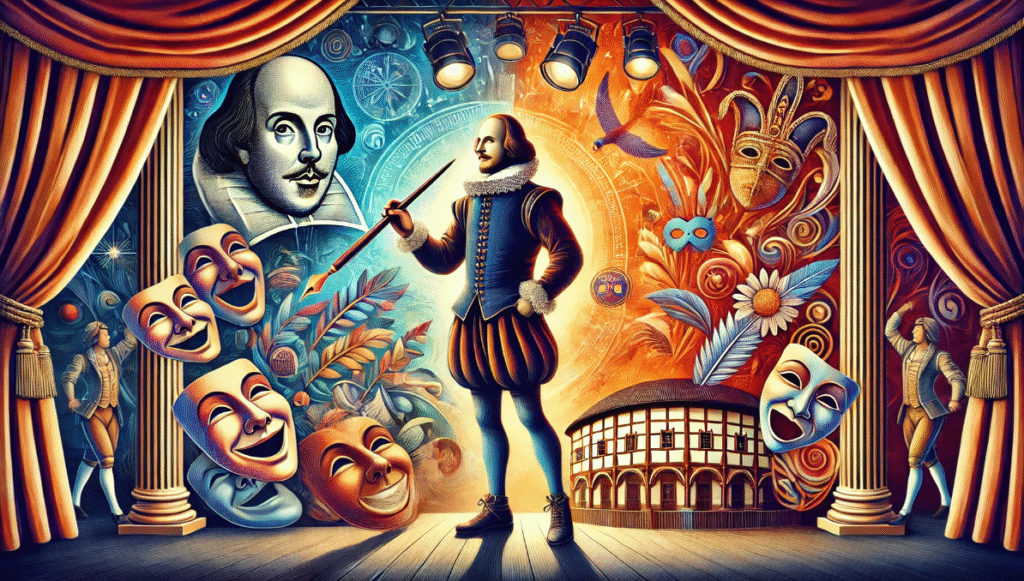
Exploring the Role of Shakespeare in Theatrical Innovations: How His Contributions Shaped Modern Theater
Imagine a world without Shakespeare’s influence on theater—a stage void of complex characters, gripping plots, and dynamic performances. Hard to picture, right? 🎭 William Shakespeare’s contributions didn’t just shape the plays of his time; they revolutionized the entire theatrical landscape, leaving a lasting legacy that still influences modern theater today. The role of Shakespeare in theatrical innovations is far-reaching, from his groundbreaking use of language to his deep understanding of human emotion and social structures.
But how exactly did Shakespeare’s innovations change the way we experience theater? And why are his works still so crucial to the stage today? In this article, we’ll explore how Shakespeare’s brilliant ideas laid the foundation for the theater we know and love, and why his influence continues to drive artistic evolution in the modern world. Keep reading to uncover the lasting impact of his genius—and how you can apply some of his techniques in today’s creative world! 🌟
Table of Contents
Toggle1: The Historical Context of Shakespeare’s Theatrical Contributions
To truly understand the role of Shakespeare in theatrical innovations, we must first look at the world of theater before his time. In the late 16th century, when Shakespeare began writing, the landscape of theater was quite different from what we know today.
The Elizabethan Theater: A New Beginning 🎭
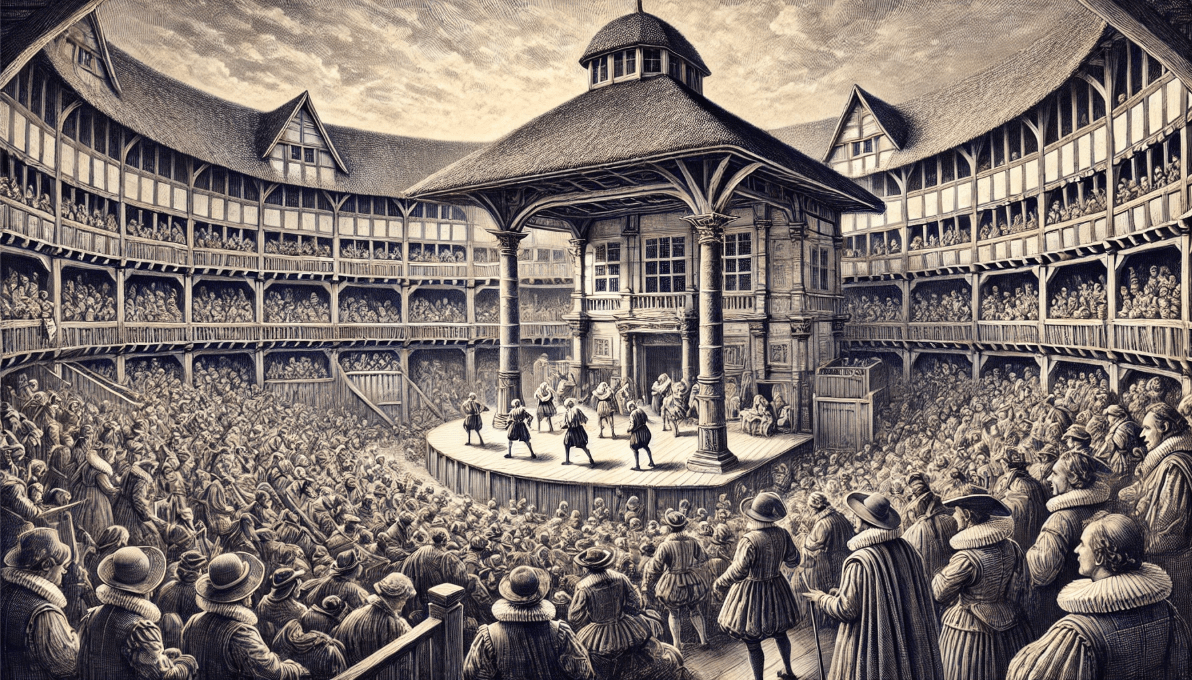
The Elizabethan era (1558-1603) was a time of great change and creativity. England was experiencing a cultural renaissance, with the arts flourishing under the rule of Queen Elizabeth I. During this period, the public theater started to gain popularity. Before then, most plays were performed in private settings or religious festivals.
The Globe Theatre, built in 1599, became one of the most famous venues for Shakespeare’s plays. It was an open-air, circular structure that could hold up to 3,000 spectators. The design itself was revolutionary, allowing actors to engage directly with the audience, a technique that broke down the “fourth wall” and brought theater to life in new ways. This interaction between actors and the audience would become a hallmark of Shakespeare’s productions.
The State of Drama Before Shakespeare 📜
Before Shakespeare’s influence, drama in England largely consisted of morality plays and mystery plays, which were religious in nature. These plays were often simple in structure and focused on teaching moral lessons or depicting biblical stories. Characters were usually one-dimensional, representing virtues or vices, making them predictable and less relatable to the audience.
Shakespeare changed this by introducing more complex characters with psychological depth and personal conflicts. He created stories that explored universal themes such as love, ambition, betrayal, and power—issues that are still relevant today.
Shakespeare’s Game-Changing Arrival ⚡
When Shakespeare entered the scene, the English stage was ripe for innovation. His writing broke away from the conventions of his time. He didn’t just tell stories; he reinvented the structure of plays, combining comedy, tragedy, and history in ways never seen before.
One of his most significant contributions was the evolution of character development. While earlier playwrights often relied on stock characters, Shakespeare’s characters were multi-layered and complex, like real people. Take Hamlet, for example—his indecision and internal conflict were revolutionary for a character in a play. This psychological depth allowed audiences to connect with the characters in a more profound way.
The Rise of Professional Theater 🎬
Shakespeare also played a key role in the rise of professional acting companies. Theaters were now staffed with trained actors, and the profession began to gain respect. Shakespeare’s works required a level of performance that demanded skill and versatility from actors. His rich language and character-driven plots pushed actors to expand their craft, setting the stage for modern acting styles.
By pushing the boundaries of theater during the Elizabethan era, Shakespeare didn’t just entertain audiences—he redefined what theater could be, making it an art form that both reflected and shaped society.
2: Shakespeare’s Key Theatrical Innovations
Shakespeare’s genius didn’t just lie in writing captivating stories—it was in how he redefined theater itself. His innovations set the stage for the modern theatrical world we enjoy today. Let’s dive into the key contributions Shakespeare made to the theater, all of which continue to inspire and influence the way we create and enjoy performances. 🌟
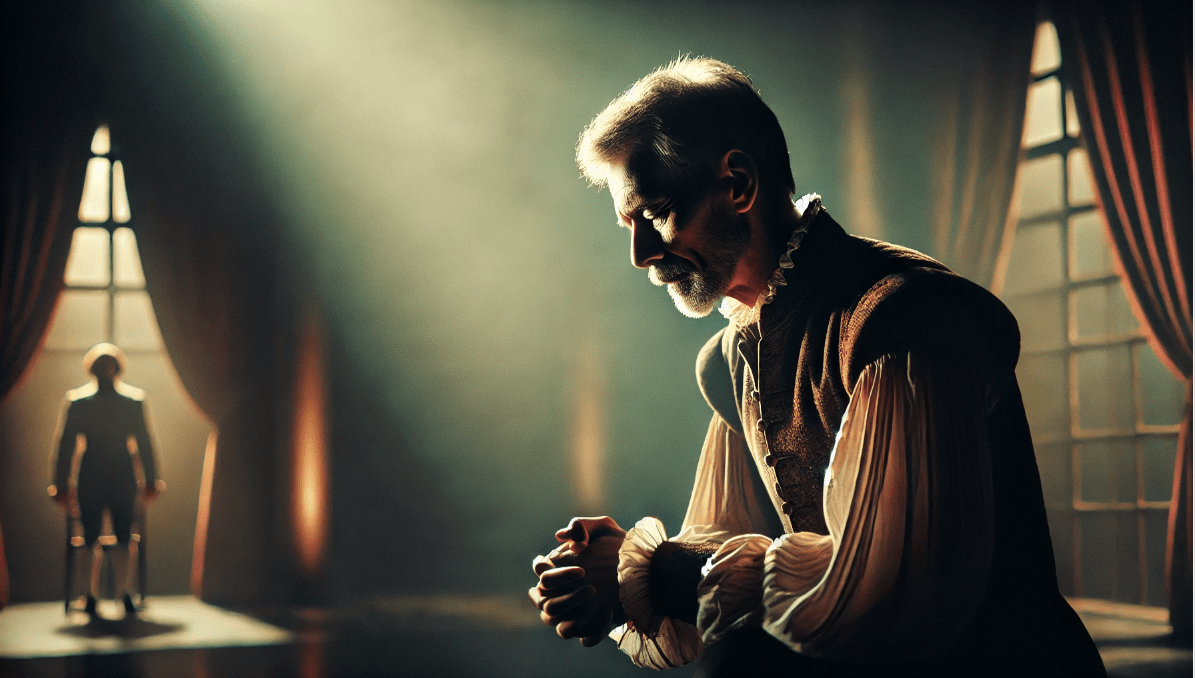
1. Complex, Multi-Dimensional Characters 🎭
Before Shakespeare, characters in plays were often one-dimensional, representing virtues or vices. Shakespeare turned this on its head by creating characters with depth, complexity, and flaws.
- Example: Hamlet, with his existential questioning and inner turmoil, was a character audiences could relate to in ways they had never experienced before.
- Impact: Modern plays, movies, and even TV shows all owe a debt to Shakespeare for creating characters that mirror the complexity of real human beings. Today, actors are expected to portray characters with internal conflict, depth, and evolving motivations—something Shakespeare mastered.
2. The Mastery of Language and Wordplay 📝
Shakespeare’s command of the English language is legendary. He didn’t just write dialogue—he shaped language itself. His use of iambic pentameter (a rhythmic pattern in which every second syllable is stressed) and wordplay made his plays a joy to listen to and perform.
- Example: His use of soliloquies, such as “To be or not to be” from Hamlet, gave characters the opportunity to express complex thoughts and emotions directly to the audience, creating a deeper connection.
- Impact: This sophisticated language set a new standard for playwrights, and today, playwrights continue to craft dialogues that reflect internal struggles and complex emotions in a similar way.
3. Blending of Genres 🎬
Shakespeare didn’t limit himself to just one genre. He masterfully blended comedy, tragedy, and history in a single play. This flexibility in genre allowed him to capture the full spectrum of human experience.
- Example: In The Merchant of Venice, Shakespeare mixes elements of comedy with moments of intense drama, creating a unique tension that keeps audiences engaged.
- Impact: Today, many modern works blend genres, creating stories that are not easily classified—mixing tragedy with humor, romance with action, and more. This versatility allows for more nuanced and dynamic storytelling.
4. Advanced Use of Structure and Plot 📚
Shakespeare was a master of dramatic structure. He perfected the five-act structure, which gave his plays a clear beginning, middle, and end, but also allowed for unexpected twists and layered subplots. This structure kept audiences on the edge of their seats, building tension and releasing it at just the right moments.
- Example: Macbeth starts with a simple prophecy and unfolds into a complex narrative of guilt, power, and supernatural influences. The pacing and rising tension keep the audience captivated.
- Impact: Modern playwrights, directors, and screenwriters still rely on Shakespeare’s blueprint for structuring their stories. His influence is seen in everything from film to TV series that explore complex plots and character arcs.
5. Breaking the Fourth Wall 👀
Shakespeare’s plays often involved characters speaking directly to the audience, creating a unique relationship between the performer and the spectator. This practice helped bridge the gap between the world of the play and reality.
- Example: In A Midsummer Night’s Dream, the character Puck addresses the audience, creating an intimate moment and breaking the illusion of the play.
- Impact: Today, the practice of breaking the fourth wall is still common in modern theater, films, and even interactive experiences like immersive theater. It draws audiences in and makes them feel part of the story.
6. Pushing the Boundaries of Set Design and Staging 🎨
Shakespeare’s plays were performed in theaters like the Globe, which were designed to create intimacy between actors and the audience. Shakespeare’s direction included innovative stage practices, such as scene changes and minimalist set designs, to focus more on the language and characters rather than elaborate sets.
- Example: The Globe’s design, with no roof and a central stage, made it possible for actors to interact directly with the audience in a way that’s still used in modern theater.
- Impact: Today, set design has evolved but still carries the influence of Shakespeare’s minimalist approach. Modern theaters often focus on symbolic staging and minimalist props, relying more on lighting and sound to create atmosphere.
3: The Lasting Impact of Shakespeare’s Innovations on Modern Theater
Shakespeare’s innovations didn’t end with his own plays—they continue to shape modern theater in powerful ways. From the structure of contemporary plays to the evolution of acting styles, the influence of his work can be seen everywhere. Let’s take a closer look at how his contributions have left an indelible mark on the world of theater today. 🌍🎭
1. Influence on Modern Playwriting ✍️
Shakespeare’s ability to blend tragedy, comedy, and history laid the groundwork for the multi-genre approach that is common in today’s theater. Contemporary playwrights borrow heavily from his ability to mix emotional depth with powerful social commentary.
- Example: Modern playwrights like Tennessee Williams (A Streetcar Named Desire) and Arthur Miller (Death of a Salesman) continue to use Shakespearean elements like complex character development and dramatic tension to explore timeless human issues such as love, guilt, and power struggles.
- Impact: Today’s plays often feature rich, multifaceted characters and explore social, psychological, and political themes—an evolution directly rooted in Shakespeare’s work. The structure of modern plays, with their shifting tones and layers of meaning, is a direct result of Shakespeare’s genre-blending approach.
2. Evolution of Acting Styles 🎬
Before Shakespeare, acting was relatively simplistic. Actors portrayed stock characters, relying on exaggerated gestures and basic emotion. Shakespeare’s works, however, called for a much more naturalistic style of acting—one that delved deep into the psychology of characters.
- Example: Think of Shakespeare’s character Macbeth, whose internal conflict and moral dilemma require subtlety and nuance to perform. This focus on the emotional depth of characters paved the way for more nuanced performances in modern theater and film.
- Impact: Modern actors are trained to analyze and portray complex emotions and internal conflicts, similar to how Shakespeare’s actors brought depth to characters like Hamlet and King Lear. Shakespeare’s influence is visible in the performances of today’s stars who engage audiences with their emotional authenticity.
3. The Rise of Tragicomedy and Genre Blending 🎭
One of Shakespeare’s most important contributions was his ability to blend comedy and tragedy in the same play. His tragicomedy style opened up new storytelling possibilities by combining laughter and tears, allowing audiences to experience a range of emotions in a single play.
- Example: The Merchant of Venice and Measure for Measure both feature moments of comedy set against darker, more tragic themes. This blend keeps audiences engaged while exploring the complexity of life.
- Impact: Today, many plays, TV shows, and movies employ this same approach. From dramedies (dramas with comedic elements) to tragicomedies, the use of mixed tones has become a staple in modern storytelling, making Shakespeare’s influence as relevant as ever.
4. Shakespeare in Film and Television 📺
Shakespeare’s influence extends far beyond the stage and into film and television. Countless adaptations of his plays have found new life on the silver screen, and his themes continue to inspire directors and writers worldwide.
- Example: Films like West Side Story (based on Romeo and Juliet) and 10 Things I Hate About You (based on The Taming of the Shrew) have taken Shakespearean plots and given them modern twists.
- Impact: Shakespeare’s influence in film can be seen in the powerful conflicts between characters, the use of language to express deeper meaning, and the timeless themes that resonate across generations. His works are still adapted to address contemporary issues, proving that his themes transcend time.
5. Shakespeare’s Impact on Theater Space and Audience Engagement 👀
Shakespeare changed the way theater interacted with its audience. In his time, the Globe Theatre and other venues created a shared experience between the performers and the audience. This interaction, where actors would engage directly with spectators, set the stage for future developments in live theater.
- Example: Modern immersive theater experiences, such as Sleep No More, borrow from Shakespeare’s technique of engaging the audience within the world of the play, blurring the lines between performers and spectators.
- Impact: Today’s immersive theater, which invites audiences to walk through the set, interact with actors, or even influence the storyline, has its roots in the audience engagement techniques Shakespeare pioneered in his open-air theaters.
6. Shakespeare’s Influence on Thematic Exploration 💡
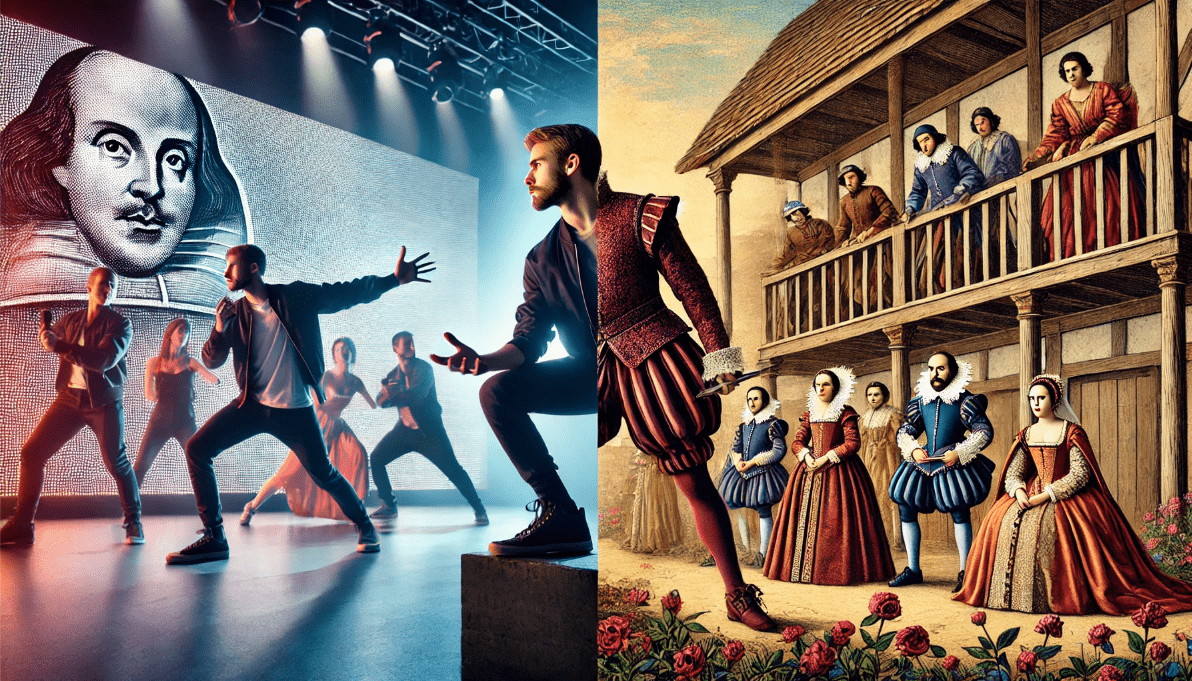
Finally, Shakespeare’s exploration of deep, universal themes like power, love, ambition, and betrayal continues to inspire playwrights and filmmakers. These themes are not only relevant but also necessary to the modern human experience, making Shakespeare’s work endlessly adaptable.
- Example: Modern political dramas and thrillers, such as House of Cards or Game of Thrones, are heavily influenced by Shakespearean themes of power struggles, corruption, and betrayal.
- Impact: Today’s stories still revolve around universal conflicts and moral dilemmas, echoing Shakespeare’s exploration of the human condition. His ability to address complex, often dark themes makes his works timeless and deeply relevant in contemporary society.
4: Practical Insights for Aspiring Actors and Playwrights
Shakespeare’s impact on theater is undeniable, and whether you’re an aspiring actor or playwright, his techniques offer valuable lessons for developing your craft. Let’s dive into some practical insights inspired by Shakespeare’s work to help you elevate your skills and bring fresh creativity to your performances or writing. 🎭✍️
1. Embrace Complex Characters and Real Emotions 💡
One of Shakespeare’s greatest strengths was his ability to craft characters with depth and internal conflict. Whether you’re acting or writing, think about how you can make your characters feel real and multi-dimensional.
- For Actors: Dive deep into your character’s motivations. What drives them? What are their fears, desires, and flaws? By understanding your character’s inner world, you can bring more authenticity to your performance.
- For Playwrights: Avoid one-dimensional characters. Give them conflicting desires, moral dilemmas, and a personal journey. These complexities are what make Shakespeare’s characters so memorable.
2. Play with Language 📝
Shakespeare’s writing is famous for its use of rich language, metaphors, and wordplay. As an actor or playwright, this technique can elevate your storytelling.

- For Actors: Shakespeare’s plays often include complex dialogue that can be challenging but also rewarding. Focus on delivering each word with intention. The rhythm, meaning, and emotional weight of the lines are essential. Don’t be afraid to experiment with the language and find what resonates with you and the audience.
- For Playwrights: Use language to express not just what characters are saying, but how they feel and who they are. Create dialogue that’s layered and open to interpretation. Let your characters speak in a way that reveals their true selves.
3. Experiment with Genre and Tone 🎬
Shakespeare was a master at blending comedy, tragedy, and history, often in the same play. This balance allowed him to keep audiences engaged while exploring the full spectrum of human emotions.
- For Actors: Don’t be afraid to switch gears between serious and light-hearted moments. Shakespeare’s plays often shift between tones, which allows for a dynamic performance. Being comfortable with both comedic and dramatic acting will give you more versatility.
- For Playwrights: Challenge yourself to mix genres in your writing. Try combining humor and sorrow, or introduce unexpected plot twists that keep the audience on their toes. This approach creates a more engaging, dynamic experience.
4. Break the Fourth Wall and Engage with the Audience 👀
Shakespeare’s actors often spoke directly to the audience, creating an intimate connection that drew people into the story. This technique of breaking the fourth wall is still used in modern theater to create engagement and make the performance feel more personal.
- For Actors: Look for moments in your performance where you can engage directly with the audience. This might be through a monologue or a subtle glance. It makes the audience feel involved and invested in the story.
- For Playwrights: Consider incorporating moments where the audience is acknowledged within your script. Breaking the fourth wall can be a powerful tool to make your play feel more interactive and impactful.
5. Structure Your Play for Maximum Impact 📚
Shakespeare mastered the five-act structure, with clear rising action, conflict, and resolution. His plays often had multiple subplots, all woven together in a way that made the story more engaging.
- For Playwrights: Use the five-act structure to plan the progression of your play. Make sure there’s a clear arc for each character and a buildup of tension that leads to a satisfying conclusion. Think about how subplots can support or contrast the main story.
- For Actors: Pay attention to how the play unfolds. Understand the pacing of the plot and how your character evolves over the course of the performance. This helps you bring more energy and purpose to each scene.
6. Don’t Shy Away from Big Themes 🌎
Shakespeare’s plays explore universal themes like love, power, ambition, betrayal, and mortality—issues that resonate across time. Incorporating these big, bold themes into your work can make it more impactful and relevant.
- For Actors: Find ways to connect your character’s struggles with universal human experiences. Shakespeare’s characters deal with timeless emotions, so tap into that in your performance. Think about how your character’s story speaks to the broader themes of the play.
- For Playwrights: Address big questions and ideas in your writing. Create characters whose actions or dilemmas touch on profound human truths. Audiences are drawn to stories that reflect their own experiences and emotions.
5: Shakespeare’s Unparalleled Legacy in Modern Theater
Shakespeare’s legacy in modern theater is nothing short of extraordinary. His contributions continue to shape how we write, perform, and experience plays today. From storytelling techniques to character development and stagecraft, Shakespeare’s innovations remain at the heart of contemporary theater. Let’s explore how his unparalleled legacy still resonates in today’s world. 🌍🎭
1. A Foundation for Modern Playwriting ✍️
Shakespeare’s ability to craft complex characters and intricate plots laid the groundwork for modern playwriting. His stories often explored universal themes like love, power, betrayal, and identity—issues that remain highly relevant.
- Influence: Today’s playwrights continue to build on Shakespeare’s foundation by creating multifaceted characters who grapple with moral dilemmas and internal conflict. Shakespeare’s exploration of human nature inspired a new way of telling stories that transcends time.
- Example: Playwrights like Tennessee Williams (A Streetcar Named Desire) and Arthur Miller (Death of a Salesman) draw on Shakespearean elements of tragedy, character complexity, and thematic depth to create emotionally charged, thought-provoking works.
2. The Evolution of Acting 🎬
Shakespeare didn’t just revolutionize the written word; his work also shaped the way actors perform. The depth of his characters requires actors to go beyond surface-level emotion and delve into psychological complexity.
- Influence: Modern acting techniques emphasize naturalism, a movement inspired by Shakespeare’s characters, who often experience inner conflict and struggle. His work taught actors to focus on subtle emotions, not just grand gestures.
- Example: Think of modern actors like Ian McKellen or Judi Dench, who bring the same complexity and nuance to Shakespeare’s roles that we expect in contemporary performances.
3. Timeless Themes that Still Resonate 💡
One of the reasons Shakespeare’s work has stood the test of time is the universal themes he explored. Love, ambition, jealousy, revenge, and the human condition are as relevant now as they were centuries ago.
- Influence: Modern theater still addresses these themes, because they speak to core human experiences. Whether a play is set in a futuristic world or modern-day city, the exploration of these emotions and dilemmas connects with audiences.
- Example: Films like The Godfather or shows like Breaking Bad echo Shakespearean themes of power, ambition, and corruption, showing how deeply his themes resonate across all mediums.
4. Influence on Film and Television 📺
Shakespeare’s works have not only influenced theater—they’ve also left an indelible mark on film and television. His plays have been adapted countless times and continue to inspire modern filmmakers and screenwriters.
- Influence: Modern films and TV shows often reflect Shakespearean plots and character types. From tragedy to comedy, Shakespeare’s narrative structure and character archetypes are still seen in today’s most popular entertainment.
- Example: The film West Side Story (a retelling of Romeo and Juliet) and 10 Things I Hate About You (based on The Taming of the Shrew) show how his stories continue to be reimagined in modern contexts, attracting new audiences.
5. The Power of Language 📝
Shakespeare’s mastery of language is one of his most significant contributions. His use of verse, metaphors, and wordplay transformed how dialogue is written and performed on stage. Modern playwrights and actors still study his language to understand the power of words.
- Influence: Shakespeare elevated language in theater to new heights, showing how words could carry emotional weight and reveal deep truths. His work has inspired playwrights to use language as a tool for emotional and intellectual exploration.
- Example: Writers like David Mamet (Glengarry Glen Ross) and Tony Kushner (Angels in America) use language with similar precision and impact to convey layered meanings, just as Shakespeare did.
6. Breaking Boundaries in Stagecraft 🎨
Shakespeare’s plays were performed in venues like the Globe Theatre, where the architecture and design allowed for direct interaction between actors and the audience. This connection continues in modern theater, where the audience is seen as an integral part of the experience.
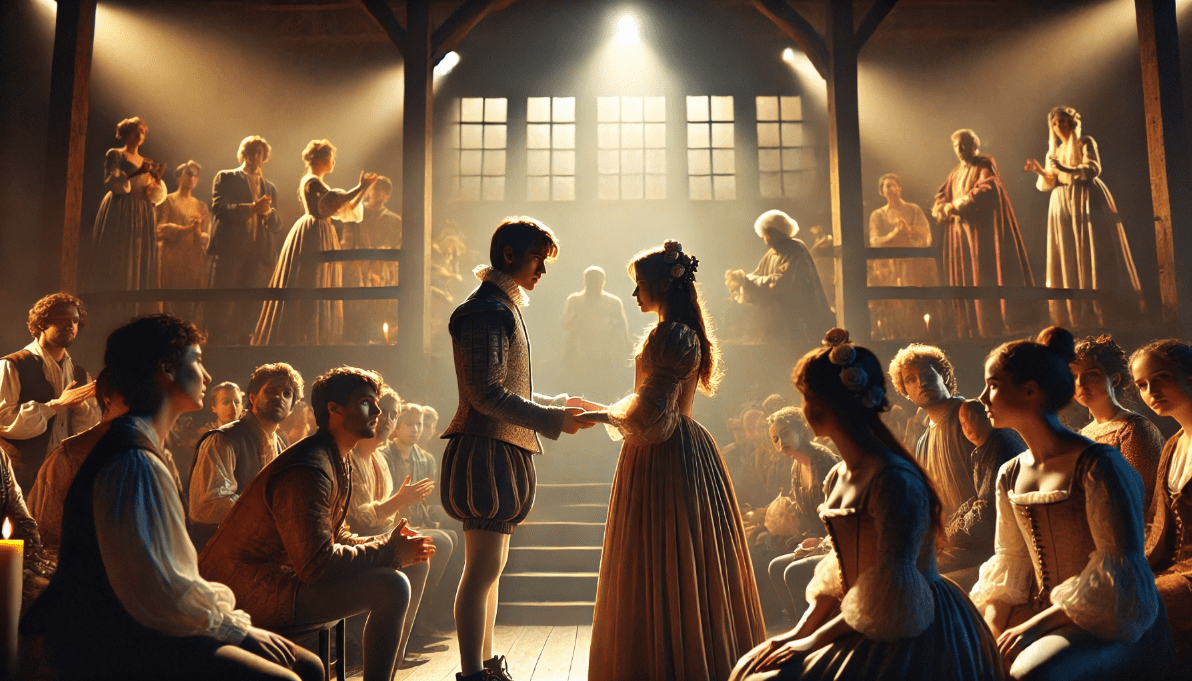
- Influence: Today, immersive and interactive theater draws directly from Shakespeare’s focus on audience engagement. By breaking the “fourth wall,” modern performances invite audiences to become part of the story, much like Shakespeare’s original performances did.
- Example: Productions like Sleep No More or The Great Gatsby employ Shakespearean techniques by making the audience active participants, reinforcing the idea that theater is a shared experience.
The Timeless Legacy of Shakespeare in Modern Theater
William Shakespeare’s contributions to the world of theater are unparalleled, and their impact is felt more deeply today than ever before. From his groundbreaking innovations in character development and storytelling to his mastery of language and stagecraft, Shakespeare has shaped the very foundation of modern theater. His works transcend time and culture, tackling universal themes that continue to resonate with audiences across generations. 🎭✨
By embracing his techniques—whether it’s creating complex characters, exploring timeless human emotions, or experimenting with genre and structure—today’s playwrights, actors, and directors are building upon a legacy that has stood the test of time. Shakespeare’s influence is evident not only in traditional theater but also in film, television, and even immersive experiences, proving that his work is as relevant today as it was in the Elizabethan era.
Frequently Asked Questions (FAQs)
1. How did Shakespeare influence modern theater?
Shakespeare revolutionized modern theater by introducing complex characters, intricate plots, and a sophisticated use of language. His blending of genres, such as comedy with tragedy, and his deep exploration of universal themes like love, power, and betrayal continue to shape how plays are written and performed today.
2. What are some of Shakespeare’s key innovations in theater?
Shakespeare’s key innovations include creating multi-dimensional characters, using iambic pentameter and soliloquies for emotional depth, and blending comedy, tragedy, and history within a single play. His unique storytelling style laid the foundation for modern acting techniques and playwriting.
3. How did Shakespeare change character development in plays?
Before Shakespeare, characters in plays were often one-dimensional. Shakespeare introduced psychologically complex characters with conflicting emotions and motivations. This depth allowed for more dynamic performances and stories that resonated with audiences on a personal level.
4. Why are Shakespeare’s works still relevant today?
Shakespeare’s works explore timeless themes such as love, ambition, power, and betrayal, which remain relevant in modern society. His ability to capture complex human emotions and conflicts makes his plays adaptable to contemporary issues, ensuring their continued popularity across different mediums.
5. How did Shakespeare impact modern acting styles?
Shakespeare’s plays encouraged actors to move beyond exaggerated gestures and focus on portraying nuanced, emotional depth. His characters often experience internal struggles, and actors today still draw on these techniques to create authentic, compelling performances.
6. How does Shakespeare’s language affect modern playwrights?
Shakespeare’s rich, poetic language and wordplay influenced modern playwrights to use dialogue not only to convey information but also to explore complex emotions. His ability to express deep meanings through words has inspired contemporary writers to focus on language as a tool for emotional and intellectual impact.
7. What role did Shakespeare play in the development of modern stage design?
Shakespeare helped shape modern stage design through the minimalist approach in his plays, focusing more on actors’ performances and less on elaborate sets. His plays often used simple props and sets, allowing for imaginative interpretations and making the actors’ storytelling the central focus.
